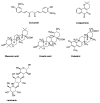Nanotechnology for Pediatric Retinoblastoma Therapy
- PMID: 36145308
- PMCID: PMC9504930
- DOI: 10.3390/ph15091087
Nanotechnology for Pediatric Retinoblastoma Therapy
Abstract
Retinoblastoma is a rare, sometimes hereditary, pediatric cancer. In high-income countries this disease has a survival rate approaching 100%, while in low- and middle-income countries the prognosis is fatal for about 80% of cases. Depending on the stage of the disease, different therapeutic protocols are applied. In more advanced forms of the disease, surgical removal of the entire globe and its intraocular contents (enucleation) is, unfortunately, necessary, whereas in other cases, conventional chemotherapy is normally used. To overcome the side-effects and reduced efficacy of traditional chemotherapic drugs, nanodelivery systems that ensure a sustained drug release and manage to reach the target site have more recently been developed. This review takes into account the current use and advances of nanomedicine in the treatment of retinoblastoma and discusses nanoparticulate formulations that contain conventional drugs and natural products. In addition, future developments in retinoblastoma treatment are discussed.
Keywords: cancer; conventional chemotherapy; nanomedicine; nanoparticle; pediatric rare disease; retinoblastoma.
Conflict of interest statement
The authors declare no conflict of interest.
Figures
References
-
- de Jong M.C., de Graaf P., Noij D.P., Göricke S., Maeder P., Galluzzi P., Brisse H.J., Moll A.C., Castelijns J.A. Diagnostic performance of magnetic resonance imaging and computed tomography for advanced retinoblastoma: A systematic review and meta-analysis. Ophthalmology. 2014;121:1109–1118. doi: 10.1016/j.ophtha.2013.11.021. - DOI - PubMed
Publication types
LinkOut - more resources
Full Text Sources



